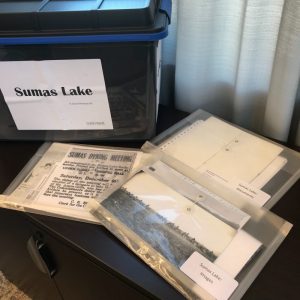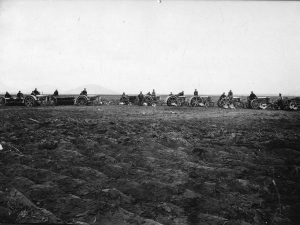Last fall while attending the University of the Fraser Valley, I took a directed studies course with history professor Scott Sheffield. The purpose of my directed studies was to create a local history kit on Sumas Lake to be used by the Chilliwack Museum and Archives. Having worked at the museum the previous two summers, I was quite familiar with the current local history kits and the type of resources they provide. From my research, I gathered materials that best depicted the vast history of Sumas Lake and the impact its drainage had on the community. While working at the Museum these past few months I have been able to complete the kit, making it an available resource for educators.

Sumas Lake Local History Kit.
To provide a brief overview, located in the Fraser Valley between Vedder Mountain and Sumas Mountain, Sumas Lake blended the border between Abbotsford and Chilliwack. In its peak season, the lake could expand to as large as 33,000 acres; on average the lake spanned 10,000 acres for the better part of the year. The lake was used by the whole community. For new settlers, it was a place for family picnics in the summer and ice-skating in the winter. For the Stó:lō people, Sumas Lake and the land that surrounded it was an important part of the daily lives and culture.
Plans to drain Sumas Lake had existed for 30-40 years, previous to the 1920’s scheme. While previous iterations of the plans failed, the project undertaken in the 1920s had several phases, culminating in the creation of two pump stations which removed (and continue to remove) water from the natural occurring lakebed on the Sumas flats. The pumps, located at Barrowtown and McGillvary Creek, were the largest of their kind in Canada when initially constructed and were capable of draining water from an Olympic-sized swimming pool in twenty seconds. The pumps began working on July 3rd, 1923 and the lake was successfully drained by June 1924, nearly a year later.
The draining of Sumas Lake is a multi-layered and complex subject, and many aspects of the drainage were (and remain) controversial to this day. The purpose of the kit is to explore the controversy, such as the impact on farmers and the local First Nations, both at the time of the drainage and current today. Through the primary and secondary sources included in the kit, ranging from newspaper articles advertising meetings regarding the reclamation project, images of tractors on the dried up lake bed, to booklets written on the overwhelming mosquito population, students have the ability to engage hands-on with their local history and make inferences as to why the lake was drained and the impact the drainage had and continues to have.

Sumas Lake tractors on lakebed floor ca. 192-. (AM 616)
Like many of our other local history kits, the Sumas Lake kit can be adapted to suit various grade levels and educators have the ability to create their own lesson plans using the information and primary and secondary materials provided in the kit to suit individual class needs.
The Sumas Lake kit is available for booking by educators for the 2018-2019 school year and can be booked online or by phone at 604-795-5210.

Comments are closed.